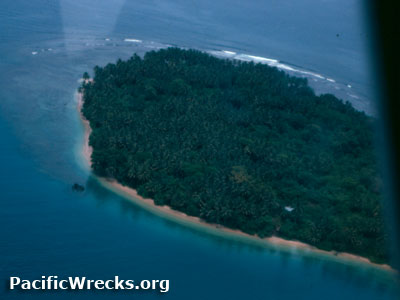|
|
|
|
| Missing In Action (MIA) | Prisoners Of War (POW) | Unexploded Ordnance (UXO) |
| Chronology | Locations | Aircraft | Ships | Submit Info | How You Can Help | Donate |
|
 USMC Dec 13, 1943  USN 1944  USN 1944  USN March 1944  David Paulley 1982  Justin Taylan 2007 |
Location Puruata Island is located in Empress Augusta Bay off the western coast of Bougainville Island. To the east is Torokina Island and beyond Torokina (Cape Torokina) on Bougainville. During the Pacific War, part of the Territory of New Guinea and considered part of the North Solomons, Northern Solomons. During 1975 became Bougainville Province in Papua New Guinea (PNG). On June 25, 2002 became the Autonomous Region of Bougainville (AROB). Wartime History During early 1942, occupied by the Japanese. By late 1943, they had dug defensive emplacements on the island that were not detected by U.S. reconnaissance planes prior to the invasion. On November 1, 1943 in the morning the U.S. invasion force entered Empress Augusta Bay and began the pre-invasion bombardment with destroyer USS Anthony (DD-515) fired 5" shells aimed at assigned targets on Puruata Island that were reported as well covered. As the transports approached, they added gunfire from their 3" guns and 20mm cannons. In fact, the bombardment was largely ineffective. As U.S. landing craft approached for the landing or came within range, they were targeted by sporadic fire from Puruata. At 7:30am the U.S. Marine Corps (USMC) Marine Raiders 3d Raider Battalion under the command of Lt. Col Fred D. Beans landed at "Green 1" on the northeast of the island. Ashore, the Raiders established a perimeter roughly 125 yards inland and faced resistance from machine guns, mortar fire and snipers. By 1:30pm the reserve platoon was committed to the battle plus gunfire from 75mm guns attached from the 9th Marines provided artillery support. By afternoon, the Marines had advanced roughly halfway across the island. Private Elmer Mapes recalls: "Puruata Island: It was my introduction to combat. Like all aboard the troopship, the USS George Clymer, I was excited and, of course, somewhat concerned about the unknown. We left Guadalcanal [on] October 30 and hit the beach at Empress Augusta Bay Nov.1, 1943. We encountered what the historians noted as 'light opposition'. We didn't actually lose very many men, but our C.O was killed there for one. My most vivid memory of getting to the beach was the strafing by 5 or 6 Jap Zeros where, as you might imagine, I 'climbed into my helmet', or at least as far as I could! Our first problem was the fact that we landed where the beach must have only been about 15 yards deep. Swampy ground behind it forced us to detour." On November 2, 1943 in the early morning, the Raiders conducted a two-pronged advance to clear the remainder of the island, encountering only sporadic rifle fire. By 3:30 all resistance had ceased and 29 Japanese dead were counted although they estimated roughly 70 were defending. The Raiders lost 5 KIA and 32 WIA. After the battle, the shore bombardment was deemed ineffective and in future operations the Marines requested supporting destroyers move as close to shore as possible to their targets. As cargo and supplies piled up on the invasion beached, excess cargo was landed at Puruata Island, but were then required to be reloaded and shuttled ashore to the mainland. On November 7, 1943 at 9:30am the Raiders departed for mainland of Bougainville to joined the 3rd Marine Division perimeter around Torokina. Torokina PT Boat Base (Torokina Base) On the morning of November 3, 1943 U.S. Navy (USN) Commander Henry Farrow arrived with eight PT-Boats to establish a PT Boat base on Puruata Island, known as Torokina PT Boat Base (Torokina Base) due to its proximity to Torokina. On November 5, 1943 one of the first missions conducted from the new base was by PT-167. By late November, the base was under the command of Lt. Commander LeRoy Taylor. On November 20, 1943 a Japanese air raid set fire to a fuel dump. During the night of December 18-19, PT-124 and PT-187 were damaged by a bomb, but were repaired by the next night. PT boats from this base covered the western coast of Bougainville and as far north as Buka. This base was active between November 1943 - March 1944. References: At Close Quarters page 141, US Marine Raiders: Puruata Island. Today Puruata Island is uninhabited. Only wild pigs to roam the island, until they are ready to be caught and eaten by their owners. The island has concrete bases, marston matting and remains of barges from the American occupation. Only wild pigs to roam the island, until they are ready to be caught and eaten by their owners. Justin Taylan visited November 1, 2007: "On November 1, 2007 MV Barbarian anchored off the island on the 63rd anniversary of the assault. Some locals visited us, and naturally we soon began talking about history and I asked them to show me around the island. They gave me a ride in their canoe and we landed at 'Green 1', just like the 3rd Raider Battalion. Since no one lives on the island, it was largely unchanged. Most of the wreckage was from the later base area, when the island served as a workshop for small ships." References History of U.S. Marine Corps Operations In World War II Bougainville and the Northern Solomons Chapter 2 Establishing Bougainville Beachhead pages 24-27, 28 (map), 32-34, 38, 42, 47, 60, 62, 74 (photo) History of U.S. Marine Corps Operations In World War II Volume II: Isolation of Rabaul Chapter 3 Assault on Cape Torokina pages 210, 211 214, 215 (photo), 216, 218, 219 Contribute
Information Last Updated
|
Map Nov 1, 1943 Photo Archive |
| Discussion Forum | Daily Updates | Reviews | Museums | Interviews & Oral Histories |
|